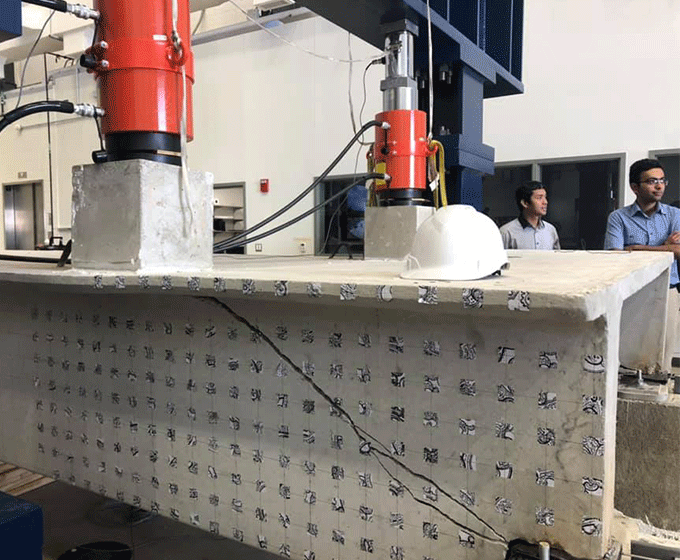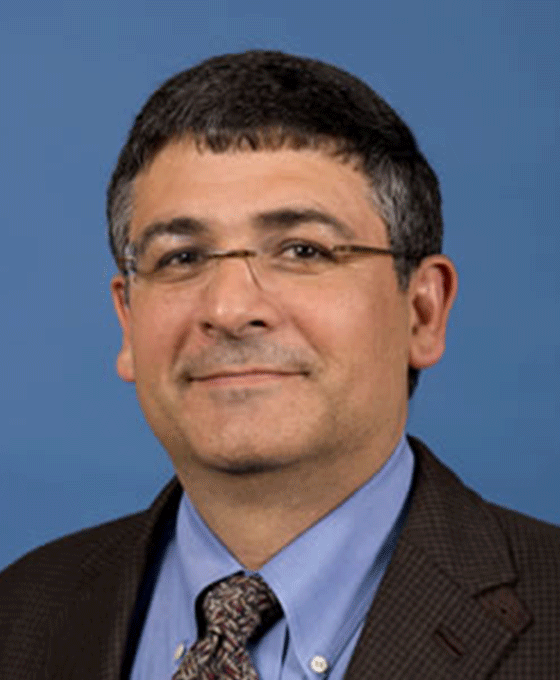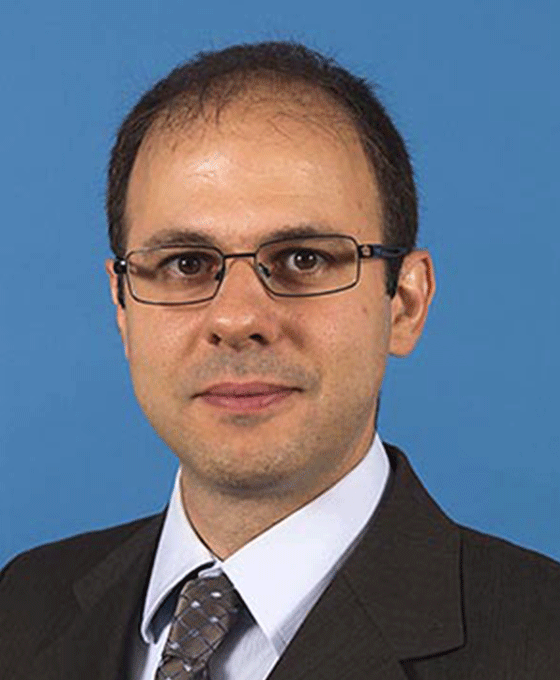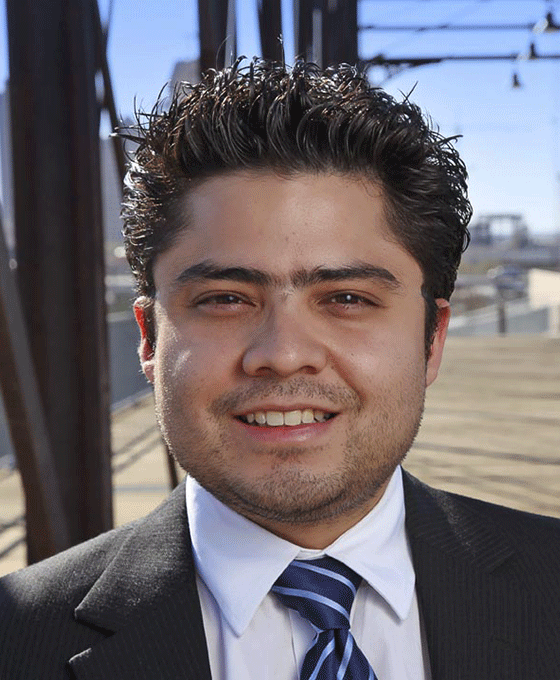
Concrete structures are tested for stress and resilience at UTSA's Large-Scale Testing Laboratory.
JULY 8, 2021 — Editor’s note: This article is the first in a three-part series about cutting-edge structural engineering research taking place at UTSA. Read the second article in the series here, and the third article in the series here.
The recent condominium collapse in Miami has raised many questions. How could a fairly modern building suddenly crumble without warning? Are other 1980s-era high-rise buildings in jeopardy of doing the same? With its commitment to innovation that benefits San Antonio and beyond, researchers in the UTSA College of Engineering and Integrated Design are studying a variety of challenges that could help prevent this puzzling tragedy.
In this first of a three-part series, UTSA Today spotlights some of the excellent research work done by UTSA engineering professors. Their expertise is a major reason why UTSA is considered one of the leading public research universities in the country.


Adolfo Matamoros, professor and Peter T. Flawn Chair in the UTSA Department of Civil and Environmental Engineering, is an expert on structural engineering. He has more than 1,200 citations in published papers related to his research in structural engineering and the design of reinforced concrete structures. After the 2017 earthquake in Puebla, Mexico, he was the trusted source for journalists looking for insight on structural damage to buildings in the quake zone and the possible effects from aftershocks.
Following the Miami condo collapse, Matamoros helped journalists understand factors, from a structural engineering perspective, that could have contributed to the building giving way.
“The team of engineers doing the forensic investigation is collecting all the drawings, images, and calculations available as well as looking for clues at the site,” Matamoros said.
These clues will help structural engineers, especially those at UTSA who specialize in this research, understand weaknesses in materials and potential building design flaws. What they learn could help prevent another unexpected condominium collapse from happening again.
“Building Codes and Standards are designed to provide a significant margin of safety against collapse, and that margin of safety protects the public. Codes are in a continuous process of revision and improvement and our UTSA faculty contribute to that process through their research,” Matamoros explained. “Structures we design today benefit from knowledge we did not have in the 1970s. The evidence gathered by the forensic team should tell us if something must change in our design codes, if there is research needed to improve our knowledge, or if this tragedy was the result of mistakes in the design and construction process.”
Meanwhile, another UTSA researcher has come up with a building process that will save time, money, and perhaps lives.

Wassim Ghannoum, associate professor in the Department of Civil and Environmental Engineering, was awarded the American Concrete Institute’s highest honor in March 2021.
ACI recognized Ghannoum for his contributions to the research paper, “Shear Behavior of Full-Scale Reinforced Concrete Members Strengthened with Anchored Carbon Fiber- Reinforced Polymer Strips.”
Ghannoum shared his findings on the complex interactions between the carbon fiber and the concrete and steel materials as they work together.
Structural engineers have used carbon fiber sheets in bridge repair for many years but with mixed results. Ghannoum found the biggest weakness with this process is the bond between the carbon and the concrete. When concrete is overstressed, it crumbles and peels off the carbon fiber sheet with it.
Instead of using sheets by themselves to cover cracks and fractures, Ghannoum developed a unique approach by taking the carbon fiber and cutting it into strips called anchors. The carbon application not only makes bridges stronger and safer, but also results in huge cost savings for everything from materials to labor and commerce. Traditional bridge repair methods take weeks to complete. Traffic has to be rerouted during repairs—which means travel delays and disruptions for the homes and businesses along the detoured path. In comparison, Ghannoum’s process takes a fraction of the time with better results.
“That was one of the big innovations, is that we anchor it correctly to the bridge. So if you apply these anchors correctly, the carbon fiber is about 10 times stronger than steel,” Ghannoum said. “We really need these methods, otherwise we’ll never tackle it. Infrastructure will bankrupt us, so we have to come up with quick, easy ways to do things.”
Ghannoum’s research was funded by the Texas Department of Transportation. He’s frequently invited to speak at conferences to share his findings, which promise to forever change the way bridges are repaired in the United States and the world.

Arturo Montoya is a Columbia University alumnus and UTSA engineering faculty member who’s making research contributions that are out of this world. He’s an associate professor with dual appointments in the Departments of Civil and Environmental Engineering and Mechanical Engineering.
Montoya’s specialty includes computational mechanics, focused on evaluating the integrity of structures. His research interests include computational modeling in civil engineering applications, advances in computational methods for solid mechanics, and deterioration of materials under corrosive environments.
Through his work at UTSA, Montoya says his research team has helped improve the integrity of buildings and bridges in the United States.
“We use new computational techniques to predict performance on a variety of structures such as bridges, aircrafts and nuclear power plants,” Montoya said. “Using advanced numerical simulations, my research team is able to predict the behavior of bridges under extreme hurricane and storm surge conditions.”
Montoya’s advanced use of computational analysis is also being applied in ground-breaking research to learn what it takes to build permanent human settlements outside of Earth. Montoya is leading UTSA’s partnership with NASA’s Resilient ExtraTerrestrial Habitats institute (RETHi). NASA has a vision to design and operate resilient deep space habitats that can adapt, absorb and rapidly recover from expected and unexpected disruptions. Montoya is contributing through his expertise in civil infrastructure with advanced technology fields such as modular and autonomous robotics and hybrid simulation. The RETHI team includes Purdue University, the University of Connecticut and Harvard.
Montoya is applying his engineering proficiency to another NASA-related engineering project. A team of UTSA professors is partnering with the start-up AstroPort Space Technologies to contribute research and development for a lunar construction project. One part of the project calls for developing methods to melt simulated lunar soil, called regolith, to create ceramic pavers required to build a launch pad on the Moon. Montoya will lead experiments to test the strength of pavers made from simulated lunar soil. The pavers need to be exceptionally strong to withstand multiple rocket launchings and landings in a lunar environment. Montoya is developing the expertise needed to address the grand challenge of permanent human settlements outside Earth.
“In addition to the excellent work by professors Matamoros, Ghannoum and Montoya, we have exceptional faculty throughout the College of Engineering and Integrated Design conducting innovative and meaningful research,” said JoAnn Browning, dean of the UTSA College of Engineering and Integrated Design. “Their collective contributions through education and the practice of engineering are leading UTSA on its way to our strategic goal of becoming an R1 research university.”
In part two, UTSA Today will take an inside look at the world-class testing facilities where UTSA engineers ply their trade. From the three-story Large-Scale Testing Laboratory to a super computer called Shamu, UTSA is committed to providing the resources for leading-edge research and unique experiential learning opportunities for students at all levels.
UTSA Today is produced by University Communications and Marketing, the official news source of The University of Texas at San Antonio. Send your feedback to news@utsa.edu. Keep up-to-date on UTSA news by visiting UTSA Today. Connect with UTSA online at Facebook, Twitter, Youtube and Instagram.
Move-in Day is an exciting time for incoming students. Students living in Laurel Village move in on August 22. The UTSA Housing and Residence Life (HRL) team looks forward to welcoming you all and helping you settle into your room.
Laurel VillageThe College of Sciences welcomes our newest Roadrunners to UTSA at VIVA Science! This interactive event connects students with faculty, staff, student leaders, and peers while highlighting the opportunities available across the College.
Outdoor Learning Environment 2 (OLE), Flawn Building, Main CampusWe're excited to welcome the new class of UTSA College of Liberal and Fine Arts (COLFA) students to campus! Move In To COLFA is strongly recommended for new students in COLFA because it gives you the chance to learn about the Student Success Center, learn how to do college successfully and meet new friends.
Galleria (MH 2.01), McKinney Humanities Building, Main CampusBuild connections with your Alvarez College of Business peers and learn more about the Career Compass program! This opportunity will provide fun interactions, giveaways and a chance to meet your next friend!
Richard Liu Auditorium (BB 2.01.02,) Business Building, Main CampusCelebrate the end of summer and the start off a great fall semester with The Housing Block Party! This event will have live music, carnival-style treats, artists, games, and activities galore. Come and join us for a night of fun!
Multipurpose Room/Lawn, Guadalupe Hall, Main CampusBe part of an unforgettable night as SOSA takes the field for its first public performance of the season! Experience the power, pride, and pageantry of UTSA’s marching band. Learn beloved traditions, practice cheers, and feel what it means to be a Roadrunner.
Campus Rec FieldsAfter getting your student settled in their room, connect with other UTSA families at our Family Get Together. Attendees need to RSVP for the event.
Rock & Brews Restaurant - 5702 Landmark Pkwy, San Antonio, TX 78249The University of Texas at San Antonio is dedicated to the advancement of knowledge through research and discovery, teaching and learning, community engagement and public service. As an institution of access and excellence, UTSA embraces multicultural traditions and serves as a center for intellectual and creative resources as well as a catalyst for socioeconomic development and the commercialization of intellectual property - for Texas, the nation and the world.
To be a premier public research university, providing access to educational excellence and preparing citizen leaders for the global environment.
We encourage an environment of dialogue and discovery, where integrity, excellence, respect, collaboration and innovation are fostered.